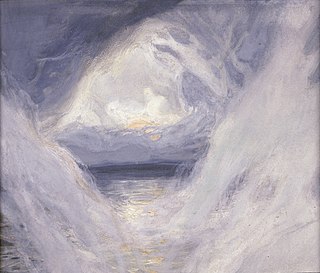
A creation myth or cosmogonic myth is a type of cosmogony, a symbolic narrative of how the world began and how people first came to inhabit it. While in popular usage the term myth often refers to false or fanciful stories, members of cultures often ascribe varying degrees of truth to their creation myths. In the society in which it is told, a creation myth is usually regarded as conveying profound truths – metaphorically, symbolically, historically, or literally. They are commonly, although not always, considered cosmogonical myths – that is, they describe the ordering of the cosmos from a state of chaos or amorphousness.

Aztec mythology is the body or collection of myths of the Aztec civilization of Central Mexico. The Aztecs were Nahuatl-speaking groups living in central Mexico and much of their mythology is similar to that of other Mesoamerican cultures. According to legend, the various groups who were to become the Aztecs arrived from the north into the Anahuac valley around Lake Texcoco. The location of this valley and lake of destination is clear – it is the heart of modern Mexico City – but little can be known with certainty about the origin of the Aztec. There are different accounts of their origin. In the myth the ancestors of the Mexica/Aztec came from a place in the north called Aztlan, the last of seven nahuatlacas to make the journey southward, hence their name "Azteca." Other accounts cite their origin in Chicomoztoc, "the place of the seven caves", or at Tamoanchan.
A creator deity or creator god is a deity responsible for the creation of the Earth, world, and universe in human religion and mythology. In monotheism, the single God is often also the creator. A number of monolatristic traditions separate a secondary creator from a primary transcendent being, identified as a primary creator.
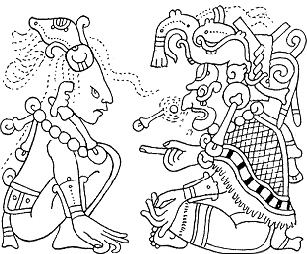
Mayan or Maya mythology is part of Mesoamerican mythology and comprises all of the Maya tales in which personified forces of nature, deities, and the heroes interacting with these play the main roles. The legends of the era have to be reconstructed from iconography. Other parts of Mayan oral tradition are not considered here.

Qʼuqʼumatz was a god of wind and rain of the Postclassic Kʼicheʼ Maya. It was the Feathered Serpent that according to the Popol Vuh created the world and humanity, together with the god Tepeu. It carried the sun across the sky and down into the underworld and acted as a mediator between the various powers in the Maya cosmos. It is considered to be the equivalent of the Aztec god Quetzalcoatl and of Kukulkan, of the Yucatec Maya.
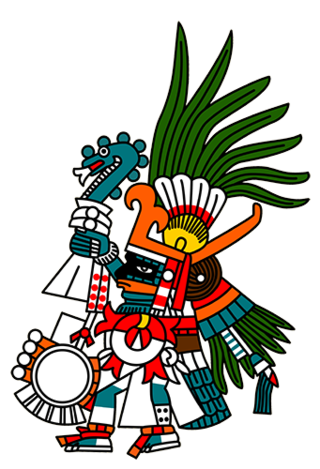
Huitzilopochtli is the solar and war deity of sacrifice in Aztec religion. He was also the patron god of the Aztecs and their capital city, Tenochtitlan. He wielded Xiuhcoatl, the fire serpent, as a weapon, thus also associating Huitzilopochtli with fire.

Huracan, often referred to as U Kʼux Kaj, the "Heart of Sky", is a Kʼicheʼ Maya god of wind, storm, fire and one of the creator deities who participated in all three attempts at creating humanity. He also caused the Great Flood after the second generation of humans angered the gods. He supposedly lived in the windy mists above the floodwaters and repeatedly invoked "earth" until land came up from the seas.

The Indigenous peoples of the Americas comprise numerous different cultures. Each has its own mythologies, many of which share certain themes across cultural boundaries. In North American mythologies, common themes include a close relation to nature and animals as well as belief in a Great Spirit that is conceived of in various ways.

Nana Buluku, also known as Nana Buruku, Nana Buku or Nanan-bouclou, is the female supreme being in the West African traditional religion of the Fon people and the Ewe people (Togo). She is one of the most influential deities in West African theology, and one shared by many ethnic groups other than the Fon people, albeit with variations. For example, she is called the Nana Bukuu among the Yoruba people and the Olisabuluwa among Igbo people but described differently, with some actively worshiping her while some do not worship her and worship the gods originating from her.

Religious cosmology is an explanation of the origin, evolution, and eventual fate of the universe from a religious perspective. This may include beliefs on origin in the form of a creation myth, subsequent evolution, current organizational form and nature, and eventual fate or destiny. There are various traditions in religion or religious mythology asserting how and why everything is the way it is and the significance of it all. Religious cosmologies describe the spatial lay-out of the universe in terms of the world in which people typically dwell as well as other dimensions, such as the seven dimensions of religion; these are ritual, experiential and emotional, narrative and mythical, doctrinal, ethical, social, and material.
Hindu cosmology is the description of the universe and its states of matter, cycles within time, physical structure, and effects on living entities according to Hindu texts. Hindu cosmology is also intertwined with the idea of a creator who allows the world to exist and take shape.
Mesoamerican creation myths are the collection of creation myths attributed to, or documented for, the various cultures and civilizations of pre-Columbian Mesoamerica and Mesoamerican literature.
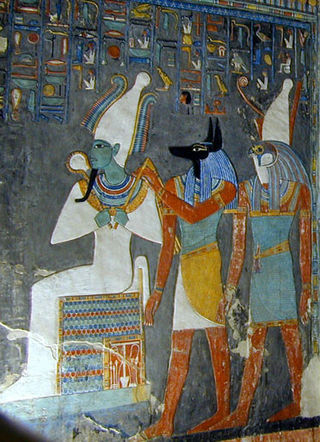
Ancient Egyptian deities are the gods and goddesses worshipped in ancient Egypt. The beliefs and rituals surrounding these gods formed the core of ancient Egyptian religion, which emerged sometime in prehistory. Deities represented natural forces and phenomena, and the Egyptians supported and appeased them through offerings and rituals so that these forces would continue to function according to maat, or divine order. After the founding of the Egyptian state around 3100 BC, the authority to perform these tasks was controlled by the pharaoh, who claimed to be the gods' representative and managed the temples where the rituals were carried out.

The Feathered Serpent is a prominent supernatural entity or deity, found in many Mesoamerican religions. It is still called Quetzalcoatl among the Aztecs, Kukulkan among the Yucatec Maya, and Q'uq'umatz and Tohil among the K'iche' Maya.

In Mesoamerican culture, Tonatiuh is an Aztec sun deity of the daytime sky who rules the cardinal direction of east. According to Aztec Mythology, Tonatiuh was known as "The Fifth Sun" and was given a calendar name of naui olin, which means "4 Movement". Represented as a fierce and warlike god, he is first seen in Early Postclassic art of the Pre-Columbian civilization known as the Toltec. Tonatiuh's symbolic association with the eagle alludes to the Aztec belief of his journey as the present sun, travelling across the sky each day, where he descended in the west and ascended in the east. It was thought that his journey was sustained by the daily sacrifice of humans. His Nahuatl name can also be translated to "He Who Goes Forth Shining" or "He Who Makes The Day." Tonatiuh was thought to be the central deity on the Aztec calendar stone but is no longer identified as such. In Toltec culture, Tonatiuh is often associated with Quetzalcoatl in his manifestation as the morning star aspect of the planet Venus.
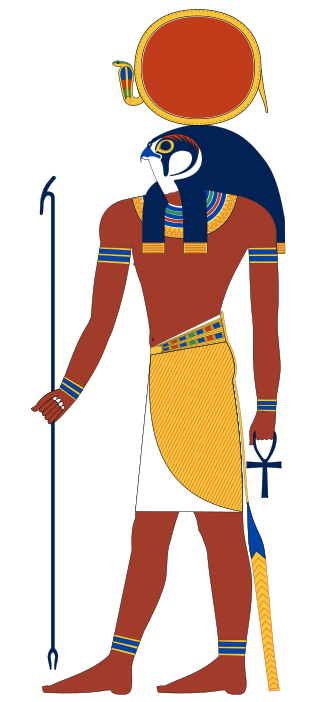
Ra or Re was the ancient Egyptian deity of the Sun. By the Fifth Dynasty, in the 25th and 24th centuries BC, he had become one of the most important gods in ancient Egyptian religion, identified primarily with the noon-day sun. Ra ruled in all parts of the created world: the sky, the Earth, and the underworld. He was believed to have ruled as the first pharaoh of Ancient Egypt. He was the god of the sun, order, kings and the sky.

The cultural perspective on Earth, or the world, varies by society and time period. Religious beliefs often include a creation belief as well as personification in the form of a deity. The exploration of the world has modified many of the perceptions of the planet, resulting in a viewpoint of a globally integrated ecosystem. Unlike the remainder of the planets in the Solar System, mankind didn't perceive the Earth as a planet until the sixteenth century.

Egyptian mythology is the collection of myths from ancient Egypt, which describe the actions of the Egyptian gods as a means of understanding the world around them. The beliefs that these myths express are an important part of ancient Egyptian religion. Myths appear frequently in Egyptian writings and art, particularly in short stories and in religious material such as hymns, ritual texts, funerary texts, and temple decoration. These sources rarely contain a complete account of a myth and often describe only brief fragments.

A deity or god is a supernatural being considered to be sacred and worthy of worship. The Oxford Dictionary of English defines deity as a god or goddess, or anything revered as divine. C. Scott Littleton defines a deity as "a being with powers greater than those of ordinary humans, but who interacts with humans, positively or negatively, in ways that carry humans to new levels of consciousness, beyond the grounded preoccupations of ordinary life".















